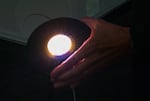
This novel LED light emits alternating blue and orange wavelengths designed to activate a circuit between the eyes and brain that affects melatonin production.
Courtesy of UW Medicine
Living through the long, sunless winter is an annual Rubicon for every resident of the Pacific Northwest. And a lot of people feel the effects — some mildly, and some with full-blown seasonal affective disorder (SAD).
Now researchers at the University of Washington have identified a potential new strategy for treating the winter blues.
The causes of SAD are not fully understood, but one leading idea is called the phase-shift hypothesis. It suggests that when the days get shorter, your body’s natural circadian rhythms get out of whack. The lack of synchronization between your internal clock and the planet’s clock can cause symptoms of depression. People with SAD are often prescribed morning light therapy, where they surround themselves with bright blue-hued light, which helps resync the body with the sun. The light triggers a photopigment in your eye, suppressing the production of melatonin (the sleepy-time hormone).
But the UW scientists are looking at light therapy from another angle. Instead of targeting the blue-light receptor, they used alternating blue and orange light — similar to the colors of sunrise — to target another, far more sensitive, receptor in the eye.
They tested the different kinds of lights on six test subjects and found the blue/orange was able to shift the body’s clock an hour and twenty minutes — twice as much as blue alone. The researchers say their findings provide a new avenue to explore in designing indoor lighting that helps people maintain a healthier internal clock.
The paper in the Journal of Biological Rhythms can be read here.
In these science snapshots, “All Science. No Fiction.” creator Jes Burns features the most interesting, wondrous and hopeful science coming out of the Pacific Northwest.
And remember: Science builds on the science that came before. No one study tells the whole story.
